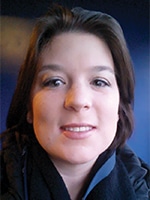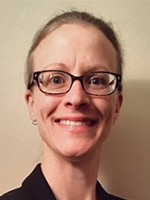Two lab educators on keeping it virtual post-pandemic
May 2022—If the pandemic proved nothing else, it proved that necessity is the mother of invention. And invention was top of mind when two like-minded employees from different institutions tackled education and training in blood banking and transfusion medicine during the past two years.
CAP TODAY spoke with Lorraine Blagg and Lynsi Rahorst about how they moved training-related processes to a virtual environment during the worst of the pandemic and adapted them so they can be offered virtually for the long term. Blagg is education and development lead, program director of the specialist in blood banking program, and education coordinator at Johns Hopkins Hospital, and Rahorst is manager of education and training for the immunohematology reference labs and genomic labs at Community Blood Center, Kansas City (a division of New York Blood Center Enterprises). Both shared their experiences in a presentation at the Association for the Advancement of Blood and Biotherapies 2021 annual meeting. Here is what they told CAP TODAY.
In a typical year, says Blagg, 70 to 80 people rotate through the transfusion medicine laboratory at Johns Hopkins Hospital, including residents, fellows, and students training to be medical laboratory technicians, medical lab scientists, and specialists in blood banking.
But 2020 was not a typical year. While pathology residents and a transfusion medicine fellow continued to come to the laboratory during the pandemic, MLS and MLT students and residents in other medical specialties did not. In addition, prospective employees had to interview for positions without seeing the laboratory. Consequently, one of the first digital tools that Blagg and her colleagues created during the pandemic was a virtual lab tour.

Blagg
“Since they weren’t physically coming into our laboratory, we were trying to give them an understanding of what we are doing and how it’s slightly different from other laboratories because we have the testing component, but we also have the component preparation, the component issuing, and the managing of those components as well,” Blagg says.
Creating the virtual tour—filmed by the lab’s evening-shift staff using an iPhone—was relatively easy, Blagg says. Executing other aspects of the project was more involved.
The project team had to adhere to Johns Hopkins’ social media requirements to post the virtual tour on YouTube. This meant using fake data in the video to protect patient privacy. This included displaying fake patient names, which had been generated in the staff training system, on a computer screen and using imitation samples labeled with fictitious patient names, which are normally used for competency assessments. The team had staff members sign waivers to participate in the video and obtained permission from hospital administration prior to filming in the lab. The video then went through a copyright infringement review, as well as a key-word optimization process to identify key words that would allow potential viewers to easily locate the video via a YouTube search.
Shortly after production began, staff realized that filming while walking around the lab made some viewers nauseous. The video was easier to watch when shot in segments, with the camera in a fixed location each time, Blagg says.
While the lab’s visitor restrictions have ended, at least for now, the virtual tour remains available on YouTube (https://tinyurl.com/49jh7n3v) as a resource for staff, students, or anyone else wanting to familiarize themselves with lab processes before coming in, Blagg says.
“Even though they are coming back with us in person, when I welcome them to the lab, the first thing I say is check out our virtual tour,” Blagg says.
Taking their virtual endeavors a step further, Blagg and her colleagues turned their attention to educating the specialist in blood banking trainees, who are hospital employees.
“Students are working all sorts of crazy shifts right now,” she explains. “Ideally, we would all be together in person, but that is not how it has been going lately.”
Therefore, Blagg began experimenting with online software programs she could use to teach hybrid remote and in-person SBB classes. After trying a few products, she settled on the Canvas online-learning management system, which includes a calendar for assignment due dates and stores content and assignments in a format that is easy for students to view and navigate.
Blagg eventually would like to use the subscription-based Articulate 360 educational software suite to create content for quizzes. Embedding quizzes into online class content will make it easier to assess whether students are understanding the concepts, she says.
While the hybrid learning environment is convenient for students, Blagg acknowledges that it presents challenges. Remote students are harder to engage, and students tend to talk over each other because they can’t hear one another as clearly, she explains. Despite this, Blagg believes online lab instruction will grow.
“Online has that potential to really challenge people to work through cases and questions, and since most certification and licensure types of exams are online anyway, computerized learning gives [students] practice in that format,” she says.
At Community Blood Center, pandemic restrictions led to the cancelation of scheduled residency rotations that the lab had hosted for many years. As the pandemic dragged on, the education team decided to provide some of that content through online modules, Rahorst says.

Rahorst
“If the company policy at the time was that we couldn’t have guests, at the very least we could say, ‘We’re sorry we can’t host you, but we have these online modules that you can use,’” she says.
The modules that Rahorst and her colleagues created covered highly specialized serologic testing taught during a weeklong rotation in the blood center’s immunohematology reference laboratory. A technologist in that lab typically spends 40 hours over five days teaching residents. But the lab education team reasoned that time spent learning background information, discussing cases, and observing rather than performing tests could be presented virtually, she says.
The team built the online modules using Articulate 360’s series of interconnected apps, which allow quizzes and other interactive features to be integrated into presentations to keep viewers engaged. The applications are user-friendly, Rahorst says, and answers to technical problems are available online.
To allow residents at Community Blood Center to observe tests performed at the bench during the pandemic, immunohematology reference lab technologist and education coordinator Shay Jones videoed himself performing benchwork using his Sony HandyCam and GoPro cameras. He then edited the videos to add his voice-over explanations of processes, Rahorst says.
“We are lucky enough to have a member of our staff who has this talent, who has the software on his computer to do this, and who is interested in this,” she adds.
The education team developed the online modules in just a few months in late 2020, Rahorst says, in part because the residency program already had its own handbook, which provided a clear-cut academic format.
When pandemic restrictions started to ease, the lab required residents to watch specific modules before each daily visit to the lab. The lab staff held a follow-up Microsoft Teams meeting daily to review the material. The hybrid online/in-person format reduced the in-person lab time from 40 hours a week to 10 and has received positive feedback, Rahorst says.
“Like everywhere, we are suffering from significant staffing problems right now, so the idea of minimizing visitor time and minimizing the lab technologist’s time away from the bench is still a priority for us,” she adds.
Not only has positive feedback from residents and staff time-savings led the blood center to use the modules indefinitely, Rahorst says, but it has led the lab to expand the scope of the modules.
Shortly after creating the residency modules, the blood center developed a series of shorter modules for medical laboratory science students that cover similar topics.
Rahorst is in the process of comparing the test scores of MLS students who participated in the hybrid online/in-person rotations to the test scores of those who solely participated in in-person rotations. The blood center hosts approximately 30 students from three MLS programs annually, which should yield a large enough sample size to quantify student performance via the online modules, she notes.
The modules are posted on the New York Blood Center website, Rahorst says, so anyone within the organization can use them to refresh their knowledge of how to perform specific lab processes.
—Renee Caruthers
CliniSys acquires ApolloLIMS
CliniSys has purchased ApolloLIMS, a provider of laboratory information management systems with a focus on clinical, public health, toxicology, and molecular diagnostics.
“Not only will they [ApolloLIMS] help expand our knowledge of diagnostics within and beyond the clinical laboratory, but they share our deep belief that the future of digital diagnostics lies in the cloud,” said CliniSys CEO Michael Simpson, in a press statement. “With the addition of ApolloLIMS, we are now poised to seize new opportunities to quickly expand our offerings in community and public health diagnostics.”
Under the arrangement, the ApolloLIMS team will join CliniSys and continue to support ApolloLIMS customers. CliniSys will, over time, integrate ApolloLIMS solutions into its product portfolio, which includes laboratory information systems, order-entry and result-consultation solutions, and public health products.
CliniSys is a sister company of Sunquest Information Systems.
ApolloLIMS, 615-834-7666
Verily and Lumea collaborate to leverage AI for prostate cancer
Lumea and Verily have entered a strategic partnership under which they will integrate Verily’s artificial intelligence algorithms into Lumea’s end-to-end digital pathology platform with the intent of improving prostate cancer diagnosis, prognosis, and therapy selection.
The companies also plan to use Lumea’s digital pathology platform and database of pathology cases to validate Verily’s Gleason algorithms for prostate cancer, which Verily developed in conjunction with Google Health.
“Partnering with Verily will give Lumea’s customers access to world-class AI without having to leave their workflow for another system or viewer,” said Lumea CEO John Wirthlin, in a press statement.
Lumea, 844-960-3658
Tempus releases AI platform to support cancer treatment
The artificial intelligence and precision medicine company Tempus has announced plans to launch Edge, a digital platform that will allow pathologists to identify cancer patients who would benefit from additional testing and may qualify for targeted therapies earlier in their care process.
Tempus has access to more than 50 petabytes of de-identified multimodal data, which it is using to develop AI models. The initial models are expected to be released as investigational algorithms under a multisite research protocol during the second half of this year.
A portfolio of models, called Tempus Histogenomics, will feature digital pathology algorithms that use a single, whole slide H&E image to predict the value of specific biomarkers, such as microsatellite instability or homologous recombination deficiency status, for patients whose samples typically are not sequenced.
Tempus is also working with pathology laboratories to create a nationwide network, called NAPA (Network of Actionable Pathology AI). The labs will be able to access the company’s portfolio of investigational AI models to identify patients who are more likely to have targetable biomarkers. In addition, the company is collaborating with Janssen Research and Development LLC and AstraZeneca to leverage the Edge platform and NAPA network to identify unique biomarkers and co-develop novel AI applications.
Tempus, 833-514-4187
Dr. Aller practices clinical informatics in Southern California. He can be reached at raller@usc.edu. Dennis Winsten is founder of Dennis Winsten & Associates, Healthcare Systems Consultants. He can be reached at dwinsten.az@gmail.com.